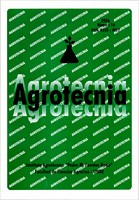Correlation between cations and anions in drilling water in Saladas Corrientes
DOI:
https://doi.org/10.30972/agr.0304662Keywords:
water, quality, irrigation, human consumption, ionsAbstract
Agriculture makes the highest demands on water worldwide. In developing countries, the amount of water used for irrigation represents more than 95% of all water uses, and plays an essential role in food production and safety. The aim of this work was to assess the correlation between cations and anions evidenced in the water in Saladas, Corrientes and to determine the quality of water samples. The correlation between cations and anions in water showed two groups of variables. The first group consisted of cations that determine salinity and hardness of water, such as sulfates, chlorides, calcium, potassium and magnesium. The second group considered alkalinity and pH. Salinity and toxicity of water are the most common risks that is why water quality is tested. The results related to sodicity and salinity indicate that the quality of water used is good enough and can be used for agricultural purposes, except in 5 out of 20 samples; that evidenced high salinity, which makes them suitable for irrigation in soils with very good permeability, due to its low sodium content that could be used for irrigation using crops tolerant to salinity. No production-limiting toxic levels were found, but levels of nitrate ion were higher than those established by the Argentine Food Code (CAA) in seven samples making them unsuitable for human consumption.Downloads
Published
2020-12-21
How to Cite
Roldán, M., Yfran Elvira, M. de las M., & Rodríguez, S. C. (2020). Correlation between cations and anions in drilling water in Saladas Corrientes. Agrotecnia, (30), 97–104. https://doi.org/10.30972/agr.0304662
Issue
Section
Notas de Investigación



